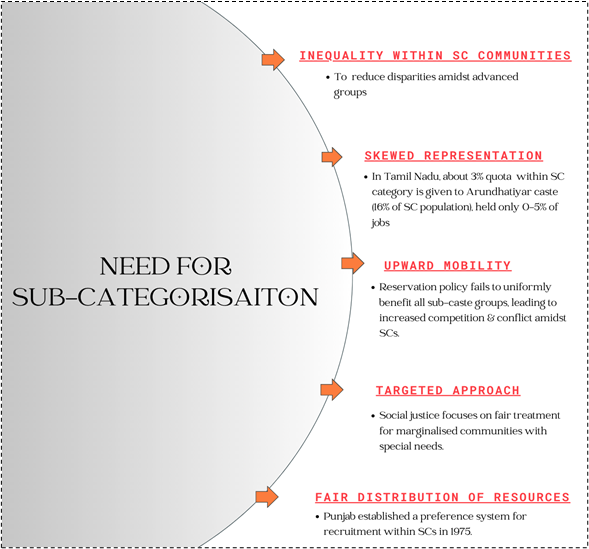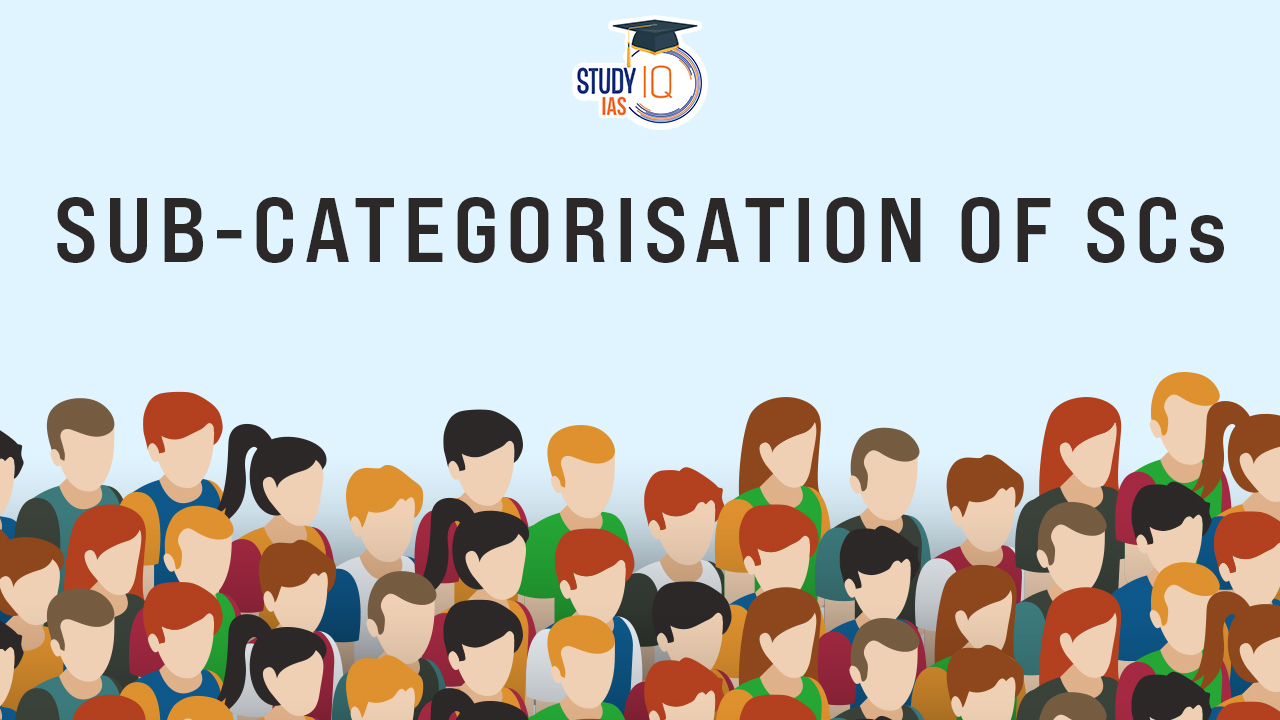Table of Contents
What was the Recent Supreme Court Verdict?
- Sub-Classification Permitted: The Court has authorised states to create sub-classifications within SCs and STs to better target support for the most disadvantaged.
- This enables separate quotas within the existing 15% SC reservation to address varying levels of backwardness.
- Empirical Basis for Sub-Classification: The ruling mandates that sub-classification must rely on empirical data and historical evidence of systemic discrimination not on arbitrary or political motives.
- Extension of Creamy Layer Principle: The Court has extended the ‘creamy layer’ principle used for Other Backward Classes (Indra Sawhney Judgment) to SCs and STs requiring states to exclude wealthier individuals within SCs/STs from reservation benefits to target support to the truly disadvantaged.
- Judicial Review of Sub-Classification: The SC has stated that state decisions on sub-classification are subject to judicial review to prevent potential misuse for political purposes.
- Restricted Reservation Benefits– The Court ruled that reservation benefits should be restricted to the first generation.
- Families with members who have already benefited from reservations and achieved higher social status may not qualify for future reservations.
| Facts |
|
Background
- Punjab Government, 1975: Punjab divided its 25% SC reservation into two categories:
- g., Balmiki and Mazhbi Sikh Communities: Given first preference for reservations in education and public employment due to being the most economically and educationally backward.
- Justice Ramachandran Commission, 1996: Andhra Pradesh formed this commission to propose sub-categorization of SCs based on varying levels of backwardness and representation.
- Andhra Pradesh Scheduled Castes (Rationalisation of Reservations) Act, 2000: Introduced an extensive list of SC communities and their respective reservation quotas in Andhra Pradesh.
- V. Chinnaiah v. State of Andhra Pradesh, 2004: The Supreme Court invalidated the 2000 Act ruling that sub-classification violated the right to equality by treating communities within the SC category differently.
- Punjab Scheduled Caste and Backward Classes (Reservation in Services) Act, 2006: Punjab attempted to reinstate sub-classification with this new act.
- Davinder Singh v. State of Punjab, 2014: The Supreme Court referred the appeal to a five-judge bench to reassess the E.V. Chinnaiah ruling and its alignment with constitutional provisions.
| Case Laws |
| ➡ E.V. Chinnaiah v. State of Andhra Pradesh, 2004: The Supreme Court ruled that SCs are a homogenous group and sub-classification within this group is unconstitutional. The decision was based on interpretation of Articles 341 and 14
➡ Dr. Kishan Pal vs. State of Punjab– The Punjab & Haryana High Court invalidated the 1975 Punjab Government notification, aligning with the E.V. Chinnaiah decision. ➡ Jarnail Singh v. Lachhmi Narain Gupta, 2018: The Supreme Court upheld the ‘creamy layer’ concept within SCs applying an income ceiling for eligibility in reservations (for promotion), a concept previously applied to OBCs. |

| Current Practices of Sub-Categorisation |
|
Issues with Caste Sub-Categorization
- Identifying criteria: Considering factors like socio-economic status, education and region is complex and reaching consensus on these criteria is challenging.
- g., Supreme Court rulings highlight that SCs are considered a class not castes and their protection focuses on addressing untouchability.
- Collecting quantifiable data: Collecting reliable socio-economic data on sub-castes through detailed surveys and studies is both resource-intensive and time-consuming.
- Social tensions: Sub-categorization may cause internal divisions and disputes among SC communities with some groups feeling marginalised and leading to social tensions.
- Risk of Fragmentation: Sub-categorization could fragment the SC community weakening their political and social identity diminishing their collective strength in advocating for their rights.
- Administrative Challenge: Establishing, managing and updating sub-categories would impose a considerable administrative load on government agencies.
Committee for Sub-categorisation of SCs
- Composition of the Committee: The Committee includes Secretaries from various ministries: Home, Law, Tribal Affairs, Social Justice, and the Department of Personnel and Training, along with the Cabinet Secretary.
- The role of the committee is to evaluate and work out a method for the equitable distribution of benefits, schemes and initiatives to the most backward communities among the over 1,200 Scheduled Castes (SCs) across the country, that have been crowded out by relatively forward and dominant ones.
- This committee’s formation is the result of the demand for sub-categorisation of Scheduled Castes as raised by the Madiga community in Telangana.
| Note |
| The Madiga community constitutes at least 50% of the SC population in Telangana, where SCs comprise around 15% of the total population (2011 Census). |
Debate on Sub-Categorization within Scheduled Castes (SCs)
Arguments in Favor
1. Addressing Graded Inequalities: Supporters of sub-categorization argue that there are significant graded inequalities among SC communities. Even within the marginalized, certain communities have limited access to basic facilities, leading to disparities.
2. Unequal Access to Benefits: It is pointed out that relatively more forward communities among SCs tend to consistently avail benefits, overshadowing the more backward ones. Sub-categorization is seen as a solution to ensure equitable distribution of reservations by providing a separate quota for the more disadvantaged communities within the SCs.
Arguments Against
1. Not Addressing Root Causes: Opponents argue that creating separate reservations within categories might not address the root cause of the problem. The focus should be on ensuring that existing schemes and government benefits reach all sections, especially the most backward communities, before considering sub-categorization.
2. Lack of Candidates for Higher Positions: Even if reservations are extended to higher levels, it is argued that the most backward SCs might not have sufficient candidates to be considered for these positions. The emphasis should be on creating opportunities and ensuring representation at all levels.
3. Need for Concrete Data: Legal experts emphasize the necessity of concrete data to support sub-categorization. They advocate for a caste census, including detailed socio-economic data for each community and sub-community. This data would serve as an empirical basis for justifying the sub-categorization of benefits and determining the additional share each community requires.
Union Government’s Position on Sub-Categorization of SCs
In 2005, the Union government deliberated on legal possibilities for the sub-categorization of Scheduled Castes (SCs). The then Attorney General of India suggested that sub-categorization could be considered feasible, but it would require compelling evidence indicating a clear necessity for such a move.
During this period, both the National Commission for Scheduled Castes (NCSC) and the National Commission for Scheduled Tribes (NCST) expressed the view that a constitutional amendment might not be essential. They argued that Article 16(4) of the Constitution already empowered states to enact special laws for any backward classes they deemed under-represented.
Additionally, the commissions emphasized that merely setting aside a quota within the existing quota might not suffice. They stressed the urgency of ensuring that the current schemes and benefits reached the marginalized communities on a priority basis. The focus was on addressing the immediate needs of these communities rather than solely relying on sub-categorization.
Way Forward
- Considering Alternatives for Sub-Categorisation: The NCSC and NCST believe Article 16(4) allows states to create special laws for under-represented backward classes.
- Data Gathering and Assessment: Legal experts say the Constitution allows Parliament to sub-categorize SCs and STs.
- g., Justice Usha Mehra Committee in 2008 recommended amending Article 341 to enable state legislatures to reclassify Scheduled Castes with Presidential approval.
- Formulate Development Metrics: Create clear and inclusive sub-categorization criteria considering socio-economic status, education, regional disparities and other relevant criteria.
- g., Methodology adopted by Justice Ramachandra Raju Commission in Andhra Pradesh in 1996 for sub categorization.
- Grievance redressal: States need to implement effective monitoring and grievance redressal systems to prevent leakage and ensure that the most disadvantaged sub-groups receive adequate support.


 New Phase of Operation Chakra to Combat ...
New Phase of Operation Chakra to Combat ...
 Soyuz Aircraft: History, Design and Sign...
Soyuz Aircraft: History, Design and Sign...
 Topological Materials: The Future of Qua...
Topological Materials: The Future of Qua...





















